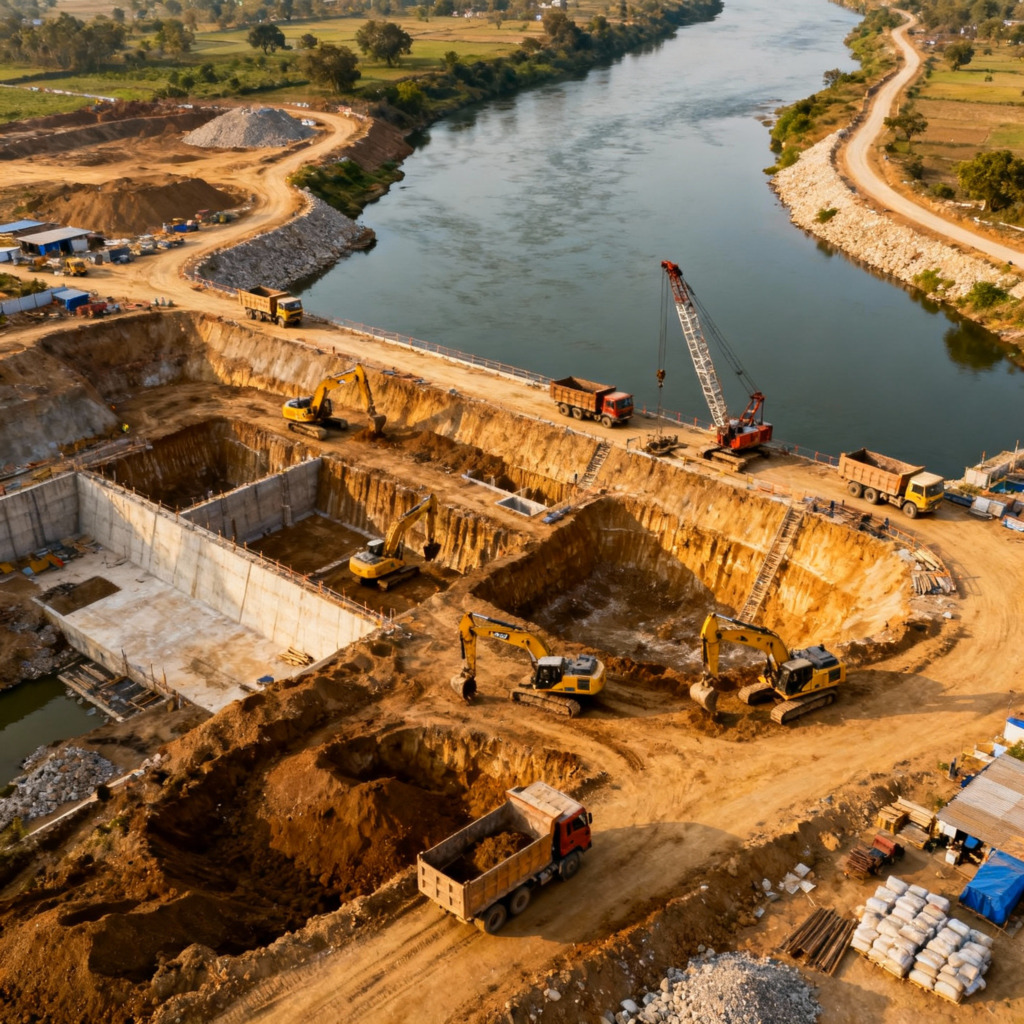Key Highlights
- India’s Water Transfer Pioneer: Ken-Betwa represents India’s first operational river interlinking project under NRLP, transferring 4,543 MCM water annually from surplus Ken River to deficit Betwa basin, costing ₹44,000 crores across two phases
- Bundelkhand Transformation Promise: Project aims to irrigate 10.62 lakh hectares, provide drinking water to 6.2 million people, and generate 127 MW renewable energy (100 MW hydro + 27 MW solar) in drought-prone region
- Severe Environmental Impact: Over 10% of Panna Tiger Reserve’s core area faces submergence, threatening 79 tigers, requiring felling of 6 million trees, and disrupting critical wildlife habitats including gharial sanctuary downstream
- Complex Social Displacement: 1,913 families across 10 villages face displacement, with tribal communities losing ancestral lands and traditional livelihoods, raising concerns about adequate rehabilitation and cultural preservation
- Climate Impact Research: New studies suggest large-scale river interlinking could reduce September rainfall in dry regions by altering soil moisture patterns, potentially undermining drought mitigation objectives
Water Revolution Begins
The Ken-Betwa Link Project (KBLP) stands as a watershed moment in India’s ambitious National River Linking Project (NRLP), representing the country’s first operational river interlinking initiative aimed at addressing the nation’s chronic water imbalance. With 30% of India’s population facing water stress and the Bundelkhand region experiencing recurring droughts, this ₹44,000 crore flagship project promises to transfer surplus water from the Ken River in Madhya Pradesh to the water-deficient Betwa River in Uttar Pradesh.
The project gained renewed momentum when Prime Minister Narendra Modi officially inaugurated the initiative on December 25, 2024, marking a significant milestone in India’s water management strategy. The KBLP envisions transforming the drought-prone Bundelkhand region through comprehensive irrigation, drinking water access for 6.2 million people, and sustainable hydropower generation. pib.gov.in

However, this ambitious undertaking has sparked intense debate among environmentalists, wildlife conservationists, and local communities who raise serious concerns about its ecological footprint on the Panna Tiger Reserve and potential social displacement of tribal populations. The project represents a classic development dilemma: balancing urgent water security needs against irreplaceable environmental heritage
Background and Genesis of the Ken-Betwa Initiative
National River Linking Project Framework
The National River Linking Project (NRLP), conceptualized in 1980, emerged from India’s urgent need to address spatial and temporal water imbalances across the subcontinent. With 18% of the world’s population but only 4% of global freshwater resources, India faces acute water stress that threatens agricultural productivity, industrial growth, and human survival. eawater.com
The NRLP encompasses 37 major rivers through a network of 3,000 storage dams, creating what proponents envision as a “gigantic South Asian water grid”. The project operates through two main components: the Himalayan Component (14 projects) connecting Ganga-Brahmaputra basins with drought-prone western states, and the Peninsular Component (16 projects) linking southern rivers for optimal water distribution.
Ken-Betwa Project Conceptualization
The Ken-Betwa Link Project falls under the Peninsular Component and represents the first tangible manifestation of India’s river interlinking vision. The Ken River, classified as “water-surplus,” flows through Madhya Pradesh’s forested regions, while the Betwa River basin in Uttar Pradesh experiences chronic water deficits that have devastated agricultural livelihoods and forced mass migration.
Historical context reveals that the Bundelkhand region once boasted 58% forest cover in 1938, but decades of deforestation, climate change, and unsustainable water practices have transformed it into a drought-prone landscape. The Ken-Betwa project aims to restore water security while potentially reviving the region’s agricultural economy.
Project Structure and Implementation Timeline
The KBLP operates through a two-phase implementation strategy:
Phase I: Construction of the 77-meter-high Daudhan Dam complex, low-level and high-level tunnels, Ken-Betwa link canal (221 km including 2 km tunnel), and powerhouses for 100 MW hydropower generation.
Phase II: Development of the Lower Orr Dam across the Orr River (Betwa tributary), Bina Complex Project, and Kotha Barrage for enhanced water storage and distribution capacity.
The Ken-Betwa Link Project Authority, established specifically for this initiative, oversees technical implementation, environmental compliance, and inter-state coordination between Madhya Pradesh and Uttar Pradesh.
Comprehensive Project Features and Engineering Marvel
Water Transfer Infrastructure
The engineering magnitude of the Ken-Betwa project involves transferring 4,543.52 MCM of water annually, with Madhya Pradesh receiving 2,350 MCM and Uttar Pradesh obtaining 1,700 MCM for irrigation, drinking water, and industrial applications. The 221-kilometer canal system includes sophisticated tunneling through challenging terrain and advanced water management technologies. theanalysis
The Daudhan Dam, positioned strategically within the Panna Tiger Reserve, will create a massive reservoir capable of storing surplus monsoon water for year-round distribution. Engineering innovations include fish ladders, sediment management systems, and environmental flow provisions to minimize ecological disruption. pib.gov
Agricultural and Rural Transformation
The project promises comprehensive irrigation for 10.62 lakh hectares of agricultural land, potentially doubling crop productivity in drought-prone areas. Advanced drip irrigation systems and precision farming techniques will optimize water utilization while reducing wastage through traditional flood irrigation methods.
Drinking water security for 6.2 million people across 13 districts in Bundelkhand addresses fundamental human needs while reducing dependency on depleted groundwater resources. The project includes water treatment facilities, distribution networks, and quality monitoring systems to ensure safe consumption.
Energy Generation and Sustainability
Renewable energy integration through 100 MW hydropower and 27 MW solar power generation demonstrates the project’s commitment to sustainable development. Hydropower generation utilizes water flow differentials between river systems, while floating solar panels on reservoir surfaces maximize energy production without additional land requirements.
Carbon footprint reduction through clean energy generation aligns with India’s climate commitments while providing economic returns through power sales to state electricity boards. Energy revenues can offset project maintenance costs and contribute to long-term financial sustainability.
Rationale and Anticipated Benefits
Drought Mitigation and Climate Resilience
Bundelkhand’s historical vulnerability to recurring droughts has created humanitarian crises, agricultural failures, and mass migration to urban centers. The Ken-Betwa project offers systematic drought mitigation through reliable water availability during critical growing seasons.
Climate resilience enhancement enables farmers to adopt diverse cropping patterns, reduce dependency on monsoon variability, and improve food security for vulnerable rural populations. Scientific water management replaces traditional rain-dependent agriculture with predictable irrigation schedules.
Economic Development and Employment
Construction phase employment involves thousands of workers across multiple skill levels, providing immediate economic benefits to local communities. Long-term operational employment includes technical positions, maintenance roles, and agricultural support services that create sustainable livelihoods.
Agricultural productivity improvements through reliable irrigation can increase farmer incomes, reduce migration pressures, and strengthen the regional economy. Value chain development in food processing, storage, and transportation creates multiplier effects for rural development.
Flood Management and Water Balance
Inter-basin water transfer addresses India’s fundamental challenge of floods in eastern regions coinciding with droughts in western areas. The Ken-Betwa system provides controlled water release during excessive monsoon periods while storing surplus for drought-prone seasons.
Flood damage reduction in downstream areas of Ken River protects agricultural lands, infrastructure, and human settlements from devastating flood impacts. Scientific water management replaces natural flood-drought cycles with predictable water availability.

Environmental and Ecological Concerns
Panna Tiger Reserve Impact
The most contentious aspect of the Ken-Betwa project involves significant environmental impact on the Panna Tiger Reserve, where over 10% of the core area (approximately 6,000 hectares) faces submergence due to dam construction. This biodiversity hotspot supports 79 tigers across 2,840 square kilometers and represents critical habitat for endangered species.
Wildlife displacement concerns extend beyond tiger populations to include vultures, gharials, jackals, and numerous bird species that depend on riverine ecosystems. Recent monitoring has detected territorial conflicts among displaced tigers, with T-2 tiger killed in territorial fighting following construction activities.
Deforestation impact involves felling approximately 6 million trees, including valuable forest species that regulate local climate patterns. Expert warnings suggest this massive tree loss could adversely affect rainfall patterns in the already dry Bundelkhand region, potentially counteracting the project’s drought mitigation objectives.
Ecological Disruption and Biodiversity Loss
River ecosystem alteration through water diversion threatens downstream ecological balance in both Ken and Betwa river systems. Natural flow regimes, sediment transport, and nutrient cycling face fundamental disruption that could affect entire food webs.
Ken Gharial Sanctuary, located downstream from the proposed dam, faces reduced water flow that threatens critically endangered gharial populations. Supreme Court Central Empowered Committee criticized the lack of assessment regarding downstream sanctuary impacts.
Invasive species introduction through inter-basin water transfer poses long-term ecological risks as alien aquatic species from Ken River could colonize Betwa ecosystem, potentially displacing native species. Pollution transfer between river basins creates additional environmental concerns.
Social Impact and Community Displacement
Tribal and Rural Community Displacement
Approximately 1,913 families across 10 villages face direct displacement due to reservoir submergence, with tribal communities bearing disproportionate impacts. These indigenous populations maintain deep cultural connections to ancestral lands and forest resources that span generations.
Livelihood disruption affects traditional occupations including agriculture, forest product collection, fishing, and animal husbandry that form the economic foundation of rural communities. Compensation and rehabilitation challenges often prove inadequate for recreating sustainable livelihoods in new locations.
Cultural heritage loss extends beyond economic impacts to include religious sites, burial grounds, and traditional landscapes that hold spiritual significance for tribal populations. Social cohesion disruption occurs when established communities scatter across different rehabilitation sites.
Resettlement and Rehabilitation Challenges
Resettlement policy implementation faces historical challenges in large infrastructure projects, with inadequate compensation, delayed rehabilitation, and poor resettlement site selection creating long-term hardships. Skills mismatch between traditional livelihoods and available opportunities in resettlement areas compounds adaptation difficulties.
Land quality disparities between original agricultural lands and allocated replacement lands often result in reduced productivity and income losses for affected farmers. Access to markets, healthcare, and educational facilities may deteriorate in remote resettlement locations.
Stakeholder Dynamics and Governance Challenges
Government Institutions and Coordination
Central Water Commission and Ministry of Jal Shakti provide technical oversight and policy guidance for project implementation, while the National Water Development Agency manages detailed planning and feasibility assessments. Inter-ministerial coordination involves Environment Ministry for environmental clearances and Tribal Affairs Ministry for community consultation.
State government cooperation between Madhya Pradesh and Uttar Pradesh requires complex negotiations over water sharing arrangements, cost distribution, and benefit allocation. Political considerations often influence project timelines and implementation priorities.
Environmental and Conservation Organizations
Wildlife conservation groups have consistently opposed the project through legal challenges, Supreme Court petitions, and public awareness campaigns highlighting irreversible environmental damage. National Board for Wildlife experts have called for independent hydrological studies and questioned the adequacy of environmental impact assessments.
Environmental NGOs advocate for alternative water management strategies including watershed development, groundwater recharge, and demand-side management as less destructive approaches to water security. Scientific community divisions reflect conflicting assessments of project benefits versus environmental costs.
Local Communities and Civil Society
Affected communities organize through village committees and civil society organizations to demand transparency in decision-making processes and adequate compensation for losses incurred. Traditional water user associations possess indigenous knowledge about local hydrology and sustainable water management practices.
Advocacy groups support community rights through legal representation, documentation of impacts, and alternative livelihood programs for displaced populations. Media coverage and public discourse increasingly scrutinize the balance between development benefits and social costs.
Economic Analysis and Financial Considerations
Cost-Benefit Assessment
The total project cost of ₹44,000 crores represents significant public investment requiring rigorous cost-benefit analysis to justify expenditure. Phase I costs of ₹18,000 crores focus on core infrastructure, while Phase II requires ₹26,000 crores for system completion and optimization.
Economic benefits include agricultural productivity gains, reduced drought relief expenditure, hydropower revenues, and industrial development opportunities in the Bundelkhand region. Quantifying environmental and social costs proves challenging but essential for comprehensive project evaluation.
Financing and Implementation Challenges
Central government funding provides primary financing, supplemented by state government contributions and potential international development funding. Cost overruns and implementation delays commonly affect large infrastructure projects, requiring robust financial management and contingency planning.
Revenue generation through hydropower sales, water charges, and economic multiplier effects can partially offset project costs over operational lifespans. Financial sustainability depends on maintaining operational efficiency and avoiding environmental degradation that could undermine project benefits.
Government Mitigation Strategies and Safeguards
Wildlife Conservation Measures
Compensatory afforestation programs aim to replace lost forest cover through plantation activities across equivalent land areas. Wildlife corridor development connects fragmented habitats and facilitates animal movement between protected areas.
Integrated Landscape Management Plan (ILMP) developed by Wildlife Institute of India under National Tiger Conservation Authority supervision covers 47,620 square kilometers across 11 districts to ensure landscape-level conservation. Greater Panna Landscape Council coordinates conservation efforts between Madhya Pradesh and Uttar Pradesh.
Community Rehabilitation Framework
Comprehensive rehabilitation packages include land compensation, livelihood restoration programs, skill development training, and priority employment in project-related activities. Community consultation processes involve village meetings, grievance redressal mechanisms, and participatory planning for resettlement sites.
Cultural preservation initiatives document traditional practices, sacred sites, and community histories to maintain cultural continuity in new settlements. Healthcare and education facilities in resettlement areas ensure access to essential services.
Environmental Monitoring Systems
Real-time environmental monitoring tracks water quality, wildlife populations, forest cover changes, and ecological indicators throughout project lifecycle. Regular reporting to regulatory authorities ensures compliance with environmental clearance conditions.
Adaptive management approaches allow course corrections based on monitoring results and emerging environmental challenges. Third-party audits provide independent assessment of environmental performance and mitigation effectiveness.
Sustainable Development and Policy Integration
Sustainable Development Goals (SDGs) particularly SDG 6 (Clean Water) and SDG 15 (Life on Land) create international commitments for balancing water access with ecosystem protection. National Water Policy and National Forest Policy provide overarching frameworks for sectoral coordination.
Climate change adaptation strategies must integrate water management with ecosystem resilience and community vulnerability reduction. Disaster risk reduction approaches can inform project design and implementation strategies.
Alternative Approaches and Way Forward
Decentralized Water Management
Watershed management focusing on catchment restoration, soil conservation, and groundwater recharge offers ecosystem-based alternatives to large-scale water transfer. Traditional water harvesting systems including check dams, farm ponds, and community tanks provide local solutions with lower environmental impact.
Demand-side management through efficient irrigation technologies, crop pattern optimization, and water recycling can reduce overall water requirements without large infrastructure investments. Participatory irrigation management empowers local communities to manage water resources sustainably.
Technology Integration and Innovation
Precision agriculture technologies including soil moisture sensors, weather-based advisories, and automated irrigation systems optimize water use efficiency. Remote sensing and GIS applications enable real-time monitoring of water resources and crop conditions.
Artificial intelligence and machine learning applications can predict water demand, optimize distribution, and detect system inefficiencies. Blockchain technology ensures transparent water allocation and usage tracking across multiple stakeholders.
Integrated Policy Framework
Basin-level planning that considers entire watersheds rather than individual projects provides holistic approaches to water management. Ecosystem services valuation quantifies environmental benefits and informs cost-benefit calculations.
Public-private partnerships can mobilize private sector expertise and financing while ensuring public accountability. International cooperation through technology transfer and financing mechanisms supports sustainable development objectives.
Conclusion
The Ken-Betwa Link Project stands at a critical juncture in India’s water management evolution, representing both the immense promise and profound challenges of large-scale infrastructure interventions in addressing water security. As India’s first operational river interlinking initiative, the project serves as a crucial test case for the broader National River Linking Project that envisions connecting 37 major rivers across the subcontinent.
The project’s ambitious scope – transferring 4,543 MCM of water annually, irrigating over 1 million hectares, and providing drinking water security to 6.2 million people in drought-prone Bundelkhand – addresses genuine humanitarian needs and regional development imperatives. The ₹44,000 crore investment reflects government commitment to transforming water-stressed regions through technological solutions and inter-basin water transfer.
However, the significant environmental costs cannot be overlooked or underestimated. The submergence of over 10% of Panna Tiger Reserve’s core area, displacement of 79 tigers, and felling of 6 million trees represents irreversible ecological damage that raises fundamental questions about sustainable development priorities. Recent research suggesting that large-scale river interlinking could reduce rainfall in already dry regions adds another layer of complexity to project justification.
Social justice concerns surrounding the displacement of 1,913 families, particularly tribal communities with deep cultural connections to ancestral lands, highlight the human costs of large infrastructure projects. Historical experience with resettlement and rehabilitation in mega-projects suggests that vulnerable populations often bear disproportionate burdens while receiving inadequate compensation.
The Ken-Betwa project ultimately reflects broader tensions in contemporary development policy: the urgent need for water security, agricultural modernization, and climate resilience versus the imperative to protect biodiversity, respect community rights, and maintain ecological integrity. Future success will depend on rigorous implementation of environmental safeguards, transparent community consultation, and adaptive management based on continuous monitoring.
Alternative approaches including decentralized watershed management, traditional water harvesting, demand-side interventions, and ecosystem-based solutions deserve serious consideration as potentially more sustainable pathways to water security. Technology integration, precision agriculture, and participatory management can enhance water use efficiency without massive environmental disruption.
Policy integration across multiple sectors – water, environment, tribal welfare, agriculture, and climate change – remains essential for holistic approaches to sustainable development. Learning from the Ken-Betwa experience will be crucial for informing the remaining 29 river interlinking projects and ensuring that future interventions achieve better balance between development objectives and environmental protection.
International experience with large-scale water transfer projects suggests that success requires not only technical excellence but also robust governance, stakeholder participation, environmental stewardship, and long-term commitment to adaptive management. The Ken-Betwa project’s legacy will ultimately be measured not just by water delivered or hectares irrigated, but by its contribution to truly sustainable and equitable development for India’s water-stressed regions.









+ There are no comments
Add yours